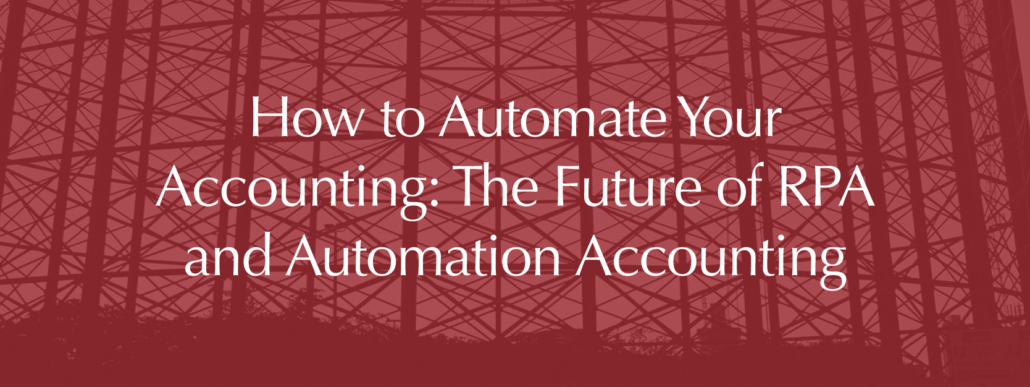How to Automate Your Accounting: The Future of RPA and Automation Accounting

Given how much accounting has changed over the last 30 years, we probably cannot even imagine the excitement that the next 30 years might bring to us in accounting. Some trends are predictable, such as accounting becoming more automated in the future, or programs being able to figure out in the future where to invoice. However, there are already quite affordable solutions which can be implemented – one of them being a software robot or RPA.
What is a Software Robot or RPA?
RPA (robotic process automation) is the process of entrusting a robot with repetitive and time-consuming activities to ensure that employees have more time for value-adding activities. Routine and time consuming activities include, for example, entering, verifying, comparing and modifying data, or gathering information from different systems. Accountants still have plenty of such work to do.
RPA is very useful when it comes to activities with different programs that cannot be combined with an API. RPA is also useful when one of the participating programs is an e-mail program, Messenger or some old-fashioned program that is not yet wanted to be replaced.
A couple of years ago, I saw a video where RPA checked documents submitted by a new employee, asked for missing documents by e-mail, confirmed to the employee by e-mail that everything was fine, then registered the person in various registers and ordered a PC for him. Wow!
Basically, RPA is an extension of the Excel macro only that macro works within Excel only, but RPA can act between different programs – cut from here, paste it when done, put the file in Drive and send the link via e-mail. Sounds incredible? Or rather genius?
It is important to understand that RPA is an algorithmic “macro”, not an AI application (artificial intelligence). RPA is just as smart or stupid as the program written by its creator. No IT person can write a proper accounting RPA alone, because RPA, which would be useful, requires the input and control of an accountant who understands the processes. For this particular reason, there are still so few applications in accounting.
RPA operating principle differs significantly from traditional system integrations. Namely is RPA capable of combining a wide variety of programs. This can be truly considered the last word in automation. In the long run, RPA will lead to lower labor costs, faster processes, an increased precision and simpler workflows. At the micro level, robots are capable of performing activities that traditional solutions never can.
Benefits of RPA for Accounting Automation:
- Fewer mistakes – automation reduces human error and saves costs.
- Efficiency growth – the robot is faster and more efficient at performing routine tasks. You get extra time to do meaningful work.
- Lower costs – robots work 24 hours a day and 7 days a week when needed, they do not take coffee breaks, get sick or want a pay raise.
- Job satisfaction – by reducing the unpleasant routine part of a person’s daily work, employees are happier. Their satisfaction and creativity are growing.
- Multiple choice – use of RPA in accounting is not limited to one particular process, it can be applied to many processes simultaneously – obligations, claims, closures, controller work, financial planning and -analysis, cost management and even taxes.
- Low requirements for conversion of existing programs – implementing RPA does not require major reorganization, RPA is both a connection and a roof, hanging above existing programs and reducing the need to make changes to existing programs.
- No boot time – unlike an employee, the robot does not require a long boot time, you can install RPA in less than a week. You just need to carefully analyze where to apply it in accounting, in order to really benefit it.
RPA solutions are fully available and usable in Estonia. We have commissioned some small convenient developments from Flowit – an Estonian IT company that has done some really cool RPA projects.
What are the activities RPA can be used for in accounting?
The following is by no means an exhaustive list, but here are some examples of RPA usage:
- data consistency and quality control, cross-program data consistency checks and troubleshooting
- balance sheet maintenance – balance sheet with analytics, including analytics in different program modules, handwritten Excel tables or in another program
- other month-end controls
- transferring data from one program to another when an API connection is not possible – it is often the case that one of the programs is very closed or outdated, but the process itself can be clearly described
- auto-fill in supplier data into the program – credit score, tax information, etc.
- retrieving customer data and periodically updating key data
- data comparison between two programs or between different modules in one program
- compare bank statement final balance and debit/credit turnover with accounting program data
- reporting, analyzing, and emailing / cloud uploading a program from the program
- sending different reminders
- adding cost breakdown data to invoices according to a given table
- generate invoices according to the received data and send invoices
- price comparison between different suppliers
- market analysis
- conducting background checks on customers and suppliers
- invoice compliance check with contract terms.
Possible problems with using RPA
RPA often depends on the visual solutions of the programs in the story – if the button location is changed in another program or website, the corresponding upgrade must also be done in RPA. RPA needs regular maintenance as well, not just building once and running for the next 5 years.
If an API connection can be used between programs, you should definitely prefer it. If it is possible to use a special program (for example, to manage purchase invoices or receipts, to forward e-mails, etc.), you could also decide to use it. But if there is no other option, RPA can be a very useful and enormously time-saving solution.
Future of automation
As already said, we probably cannot even imagine the excitement that the next 30 years might bring us in accounting. However, there are some trends that can be anticipated in addition to the software robot.
Reports. One definite solution for the future is the smart apps, collecting data from various sources, drawing then the desired analyzes and data from them. Building smart apps requires the development team to have at least one smart accountant-controller who understands the details where the data comes from or how the report is put together. There are still very few such solutions and IT people cannot handle them alone.
Real time accounting. In the future, all financial transactions will be logged immediately and automatically, analytics will be available already in the next morning. In some sections we may have almost reached it, but there is still room for improvement.
Learning programs. The ability to learn is definitely on the rise. For example, when a new e-invoice arrives, the program can read the invoice content (for example – a mobile phone) and suggests that the appropriate account is 5340 Telephone Expenses.
Read further on a topic:
How to Automate Your Accounting: Sale Transactions
How to Automate Your Accounting: Purchase Invoices and Cheques

Leave a Reply
Want to join the discussion?Feel free to contribute!